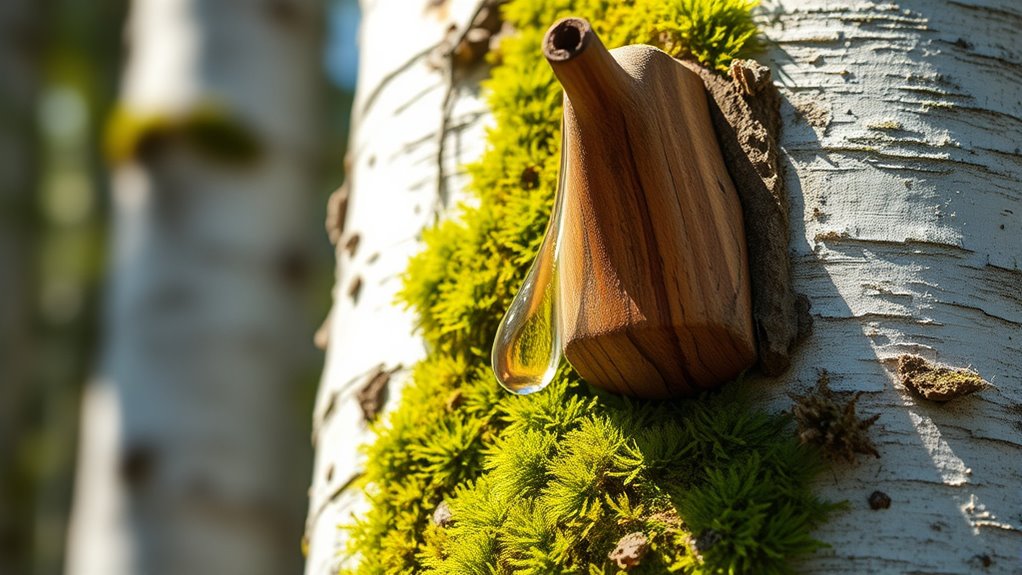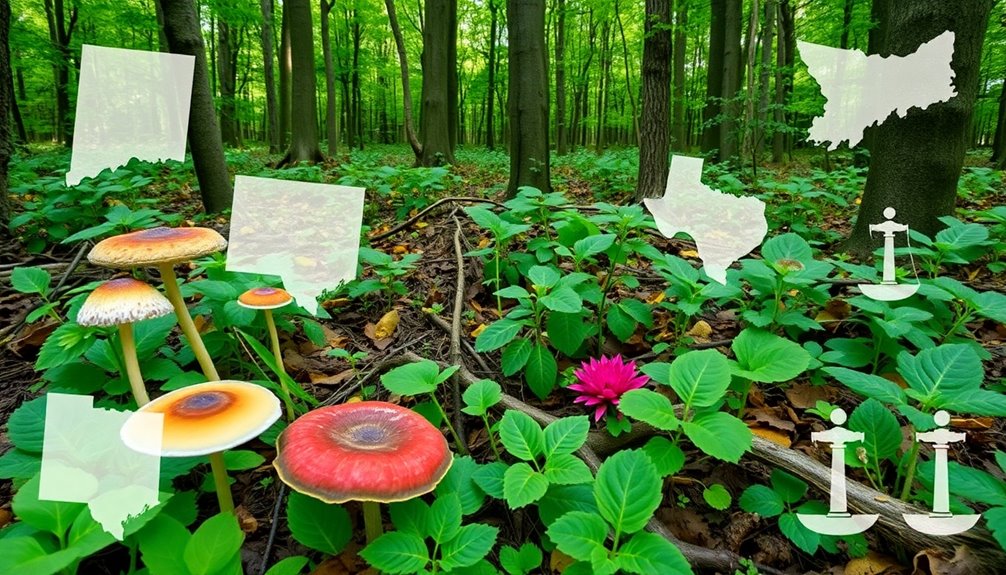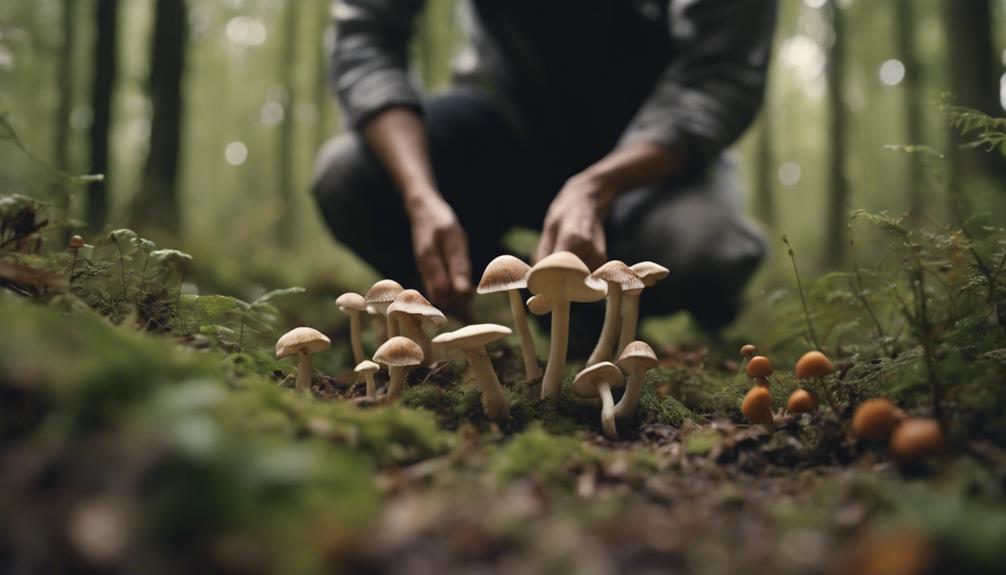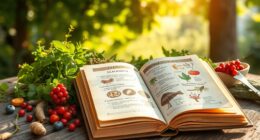To make your own wild sugar, select healthy maples, birches, or other taphable trees with a good flow of sap. Drill a small hole at an angle, insert a tap, and collect the sap in clean containers. Boil the sap down slowly to concentrate it into syrup or sugar, monitoring its color and temperature. Following these simple, sustainable steps lets you craft delicious natural sweeteners—continue exploring for detailed tips and techniques.
Key Takeaways
- Choose healthy, mature trees like maple or birch, drill a shallow, angled hole, and insert a tap to collect sap sustainably.
- Monitor sap flow during the tapping season, collecting consistently to ensure quality and avoid harming the tree.
- Boil the collected sap over steady heat, stirring occasionally, until it thickens into syrup with a rich amber color.
- Use a thermometer or drip test to determine when the syrup reaches the proper consistency, then cool and store in sterilized containers.
- Practice sustainable harvesting to protect tree health, enjoy the process, and create homemade wild sugar for culinary use.

Ever wondered how to create your own wild sugar at home? It’s easier than you might think, especially if you’re interested in tapping into nature’s sweet offerings. The journey begins with tree tapping—carefully drilling a small hole into a mature tree, like a maple or birch, to access the sap. You want to choose a healthy, established tree with a good flow of sap, typically one that’s at least 10 inches in diameter. Using a clean, sharp drill bit, make a hole about 1.5 to 2 inches deep at a slight upward angle to prevent sap from pooling. Insert a spile or tap into the hole, then hang a collection bucket underneath to gather the sap as it flows. During the tapping season, which varies depending on your region and the weather, you’ll notice sap steadily dripping into your container. This sap is mostly water with a touch of natural sugars, and it’s the foundation for making your wild sugar. Proper tapping techniques help ensure the health of your trees and a sustainable harvest.
Once you’ve collected enough sap, it’s time for syrup boiling. Transfer your sap to a large, clean pot and heat it over a steady fire or stove. As the sap heats up, the water begins evaporating, thickening the liquid and concentrating its sugars. Keep a close eye on it, stirring occasionally to prevent sticking or burning. The boiling process can take several hours, and you’ll notice the color deepening from clear to a rich amber hue. This is a sign that the sugar content is increasing. To determine if your syrup has reached the right consistency, you can use a candy thermometer—aiming for about 219°F (104°C)—or do a simple drip test on a cold plate. Once it reaches the desired thickness, remove the pot from heat and let the syrup cool slightly before pouring it into sterilized jars or bottles.
Making wild sugar at home requires patience, but the results are worth it. The entire process of tree tapping and syrup boiling lets you connect directly with nature and enjoy a pure, homemade product. Whether you’re after traditional maple syrup or exploring birch and other trees, each step is straightforward but essential. Properly tapping your trees ensures the health of the tree and a sustainable harvest. Boiling down the sap transforms a simple liquid into a flavorful, sweet treat you can enjoy on pancakes, waffles, or even in baked goods. With just a few tools and a little time, you’ll turn wild sap into delicious, homemade sugar—an authentic reward from your local trees. Embracing sustainable harvesting practices ensures that these natural resources remain available for future generations.
Frequently Asked Questions
How Do I Identify the Best Trees for Sap Collection?
To identify the best trees for sap collection, focus on tree identification by examining bark, leaves, and overall shape. Look for healthy, mature trees with smooth bark or distinctive markings. Check sap flow indicators like visible sap wells or fresh sap flow during the season. You want trees that produce abundant sap, so observe signs of active flow and avoid stressed or damaged trees for the best yield.
What Safety Precautions Are Necessary When Tapping Trees?
Did you know that improper tapping can harm up to 30% of a tree’s health? When you tap trees, always prioritize safety gear like gloves, eye protection, and proper tools. Confirm the tree is healthy before tapping, avoiding signs of disease or damage. Be cautious of falling branches and use secure ladders. These precautions protect both your safety and the tree’s health, ensuring a sustainable and safe sap collection process.
Can Sap Be Collected During Rainy or Snowy Weather?
Rainy or snowy weather can impact sap collection because weather impacts sap flow. During heavy rain or snow, sap flow slows down or stops, making it less effective to tap trees. It’s best to wait for clear, slightly warm days when sap flow is strong. Collecting during bad weather can lead to lower yields and may cause damage to the tree or equipment.
How Long Does the Sap Harvesting Season Typically Last?
Think of the sap harvesting season as a fleeting river, flowing for weeks before it runs dry. It usually lasts 4 to 8 weeks, depending on weather and temperature. You’ll spend days collecting sap, then boiling it down to syrup. Proper syrup storage keeps it fresh, ensuring your sweet bounty endures beyond the season’s end. Stay attentive, and you’ll capture the essence of nature’s gift at its peak.
Are There Sustainable Practices to Minimize Tree Damage?
You can minimize tree damage by adopting sustainable tapping practices. Use proper tapping techniques that avoid over-inserting spiles, and limit the number of taps per tree to protect tree health. Regularly monitor the trees for signs of stress or damage, and avoid tapping during extreme weather. These practices help reduce environmental impact, ensuring the trees remain healthy and productive for years to come.
Conclusion
Now that you know how to tap into nature’s sweet bounty, you’re ready to create your own wild sugar. Think of it as discovering a hidden treasure chest, waiting just beneath the bark of a tree. With patience and a little effort, you’ll harvest flavors as unique as each tree and turn them into delicious, homemade syrup. So grab your gear and start your sweet adventure—nature’s bounty is calling, and the possibilities are endless!










